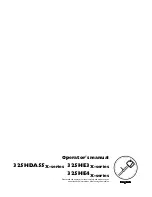
English
4
Additional Safety Information
WARNING:
Never modify the power tool or any part of
it. Damage or personal injury could result.
WARNING: ALWAYS
use safety glasses. Everyday
eyeglasses are NOT safety glasses. Also use face or
dust mask if cutting operation is dusty. ALWAYS WEAR
CERTIFIED SAFETY EQUIPMENT:
• ANSI Z87.1 eye protection (CAN/CSA Z94.3),
• ANSI S12.6 (S3.19) hearing protection,
• NIOSH/OSHA/MSHA respiratory protection.
•
Use clamps or another practical way to secure and
support the workpiece to a stable platform.
Holding
the workpiece by hand or against your body leaves it
unstable and may lead to loss of control.
•
ALWAYS wear a dust mask.
Exposure to dust particles
can cause breathing difficulty and possible injury.
•
Never
switch on the tool when the saw blade is jammed in
the workpiece or in contact with the material.
•
Keep hands away from moving parts.
Never place your
hands near the cutting area.
•
Use extra caution when cutting overhead and pay
particular attention to overhead wires which may be
hidden from view.
Anticipate the path of falling branches
and debris ahead of time.
•
Do not operate this tool for long periods of time.
Vibration caused by the operating action of this tool may
cause permanent injury to fingers, hands, and arms. Use
gloves to provide extra cushion, take frequent rest periods,
and limit daily time of use.
Switching On and Off
• After switching off, never attempt to stop the saw blade
with your fingers.
• Never put the saw down on a table or work bench unless
switched off. The saw blade will keep running briefly after
the tool has been switched off.
When Sawing
• When using saw blades specially designed for cutting wood
remove all nails and metal objects from the workpiece
before starting work.
• Wherever possible, use clamps and vices to fasten the
workpiece securely.
• Do not attempt to saw extremely small workpieces.
• Do not bend too far forward. Make sure that you always
stand firmly, particularly on scaffolding and ladders.
• Always hold the saw with both hands.
• For cutting curves and pockets, use approved accessories.
Checking and Changing the Saw Blade
• Only use saw blades conforming to the specifications
contained in these operating instructions.
• Only sharp saw blades in perfect working condition should
be used; cracked or bent saw blades should be discarded
and replaced at once.
• Ensure that the saw blade is securely fixed.
SAVE THESE INSTRUCTIONS
Additional Safety Instructions for
Reciprocating Saws
•
Hold power tool by insulated gripping surfaces when
performing an operation where the cutting accessory
may contact hidden wiring or its own cord.
Cutting
accessory contacting a “live” wire will make exposed metal
parts of the power tool “live” and could give the operator an
electric shock.
h )
Do not let familiarity gained from frequent use of
tools allow you to become complacent and ignore
tool safety principles.
A careless action can cause
severe injury within a fraction of a second.
4) Power Tool Use and Care
a )
Do not force the power tool. Use the correct power
tool for your application.
The correct power tool
will do the job better and safer at the rate for which it
was designed.
b )
Do not use the power tool if the switch does not
turn it on and off.
Any power tool that cannot be
controlled with the switch is dangerous and must
be repaired.
c )
Disconnect the plug from the power source and/
or remove the battery pack, if detachable, from
the power tool before making any adjustments,
changing accessories, or storing power tools.
Such
preventive safety measures reduce the risk of starting
the power tool accidentally.
d )
Store idle power tools out of the reach of children
and do not allow persons unfamiliar with the
power tool or these instructions to operate the
power tool.
Power tools are dangerous in the hands of
untrained users.
e )
Maintain power tools and accessories. Check
for misalignment or binding of moving parts,
breakage of parts and any other condition
that may affect the power tool’s operation. If
damaged, have the power tool repaired before
use.
Many accidents are caused by poorly maintained
power tools.
f )
Keep cutting tools sharp and clean.
Properly
maintained cutting tools with sharp cutting edges are
less likely to bind and are easier to control.
g )
Use the power tool, accessories and tool bits etc.
in accordance with these instructions, taking
into account the working conditions and the
work to be performed.
Use of the power tool for
operations different from those intended could result in
a hazardous situation.
h )
Keep handles and grasping surfaces dry, clean
and free from oil and grease.
Slippery handles and
grasping surfaces do not allow for safe handling and
control of the tool in unexpected situations.
5) Service
a )
Have your power tool serviced by a qualified
repair person using only identical replacement
parts.
This will ensure that the safety of the power tool
is maintained.







































